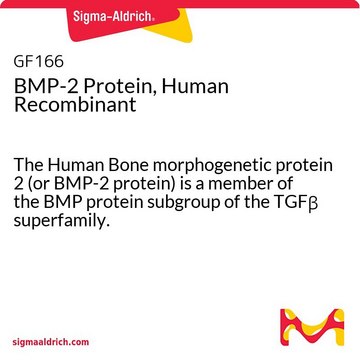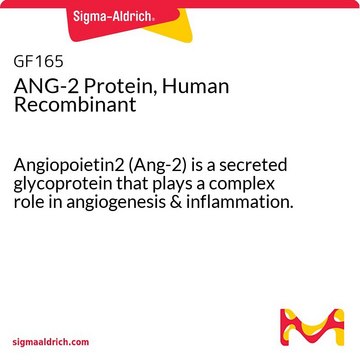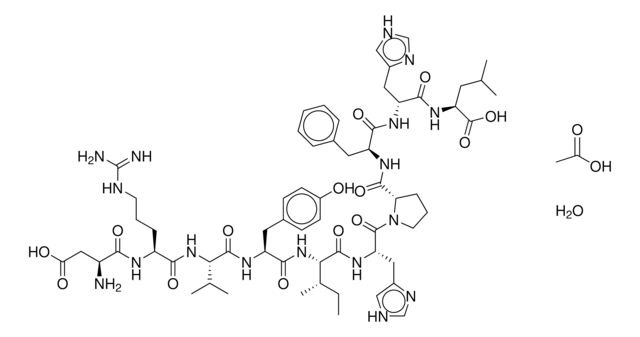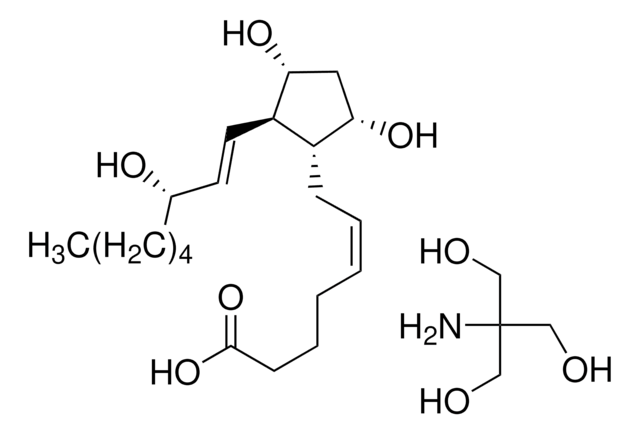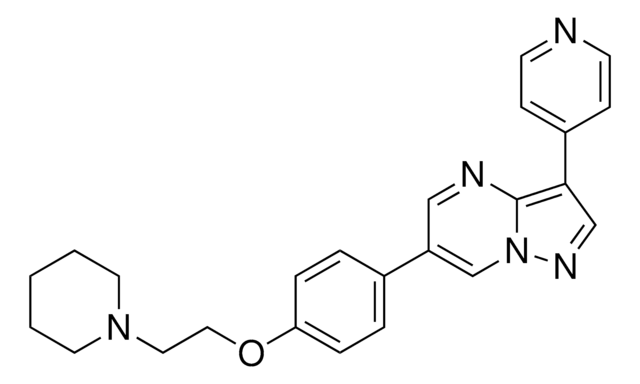GF164
ANG-1 Protein, Human Recombinant
The Ang-1 protein & Ang-2 protein are secreted ligands which bind with similar affinity to Tie2, a receptor tyrosine kinase with immunoglobulin & epidermal growth factor homology domains expressed on endothelial & early hematopoietic cells.
Sinonimo/i:
ANG1, Angiopoietin1, Hepatic fibrinogen/angiopoietin-related protein, PPARG angiopoietin related protein, angiopoietin-like 4, angiopoietin-like 4 protein, angiopoietin-related protein 4
Autenticatiper visualizzare i prezzi riservati alla tua organizzazione & contrattuali
About This Item
Codice UNSPSC:
12352202
eCl@ss:
32160405
NACRES:
NA.77
Prodotti consigliati
Descrizione generale
Angiopoietin1 (Ang1) and Angiopoietin2 (Ang2) are two closely related secreted ligands which bind with similar affinity to Tie2,
a receptor tyrosine kinase with immunoglobulin and epidermal growth factor homology domains expressed primarily on endothelial cells and early hematopoietic cells. Tie2 and angiopoietins have been shown to play critical roles in embryogenic angiogenesis and in maintaining the integrity of the adult vasculature. Ang-1/Tie-2 signaling appears to be regulated by Angiopoietin-2 (Ang-2), a natural antagonist for Tie-2 that exerts its effects through an internal autocrine loop mechanism. In addition to suppressing endothelial cell activation by inhibiting the expression of adhesion and inflammatory molecules, Ang-1 enhances endothelial cell survival and capillary morphogenesis, and lessens capillary permeability. As such, Ang-1 has a potential to become an effective therapeutic agent for treating various endothelium disorders, including several severe human pulmonary diseases. Recombinant human ANG-1, derived from HeLa cells, is a C-terminal histidine tagged glycoprotein which migrates with an apparent molecular mass of 60.0 – 70.0 kDa by SDS-PAGE under reducing conditions. Sequencing analysis shows N-terminal sequences starting with Ser-20 and with Asp-70 of the 498 amino acid precursor protein.
a receptor tyrosine kinase with immunoglobulin and epidermal growth factor homology domains expressed primarily on endothelial cells and early hematopoietic cells. Tie2 and angiopoietins have been shown to play critical roles in embryogenic angiogenesis and in maintaining the integrity of the adult vasculature. Ang-1/Tie-2 signaling appears to be regulated by Angiopoietin-2 (Ang-2), a natural antagonist for Tie-2 that exerts its effects through an internal autocrine loop mechanism. In addition to suppressing endothelial cell activation by inhibiting the expression of adhesion and inflammatory molecules, Ang-1 enhances endothelial cell survival and capillary morphogenesis, and lessens capillary permeability. As such, Ang-1 has a potential to become an effective therapeutic agent for treating various endothelium disorders, including several severe human pulmonary diseases. Recombinant human ANG-1, derived from HeLa cells, is a C-terminal histidine tagged glycoprotein which migrates with an apparent molecular mass of 60.0 – 70.0 kDa by SDS-PAGE under reducing conditions. Sequencing analysis shows N-terminal sequences starting with Ser-20 and with Asp-70 of the 498 amino acid precursor protein.
Product Source: Hela Cells
Specificità
Cross Reactivty
None
None
Applicazioni
Research Category
Stem Cell Research
Stem Cell Research
Research Sub Category
Growth Factors & Receptors
Growth Factors & Receptors
Qualità
Bioactivity assay: Determined by its ability to induce adhesion of human umbilical vein endothelial cells (HUVEC).
Stato fisico
Product is filtered through a 0.2 micron filter before lyophilization.
Stoccaggio e stabilità
Store at -20°C for up to 6 months from date of receipt.
Esclusione di responsabilità
Unless otherwise stated in our catalog or other company documentation accompanying the product(s), our products are intended for research use only and are not to be used for any other purpose, which includes but is not limited to, unauthorized commercial uses, in vitro diagnostic uses, ex vivo or in vivo therapeutic uses or any type of consumption or application to humans or animals.
Codice della classe di stoccaggio
11 - Combustible Solids
Classe di pericolosità dell'acqua (WGK)
WGK 3
Certificati d'analisi (COA)
Cerca il Certificati d'analisi (COA) digitando il numero di lotto/batch corrispondente. I numeri di lotto o di batch sono stampati sull'etichetta dei prodotti dopo la parola ‘Lotto’ o ‘Batch’.
Possiedi già questo prodotto?
I documenti relativi ai prodotti acquistati recentemente sono disponibili nell’Archivio dei documenti.
Il team dei nostri ricercatori vanta grande esperienza in tutte le aree della ricerca quali Life Science, scienza dei materiali, sintesi chimica, cromatografia, discipline analitiche, ecc..
Contatta l'Assistenza Tecnica.